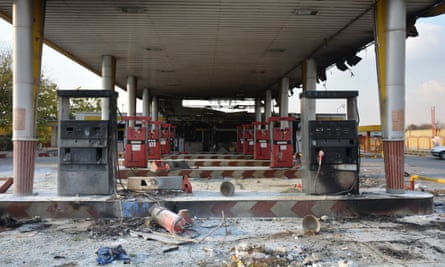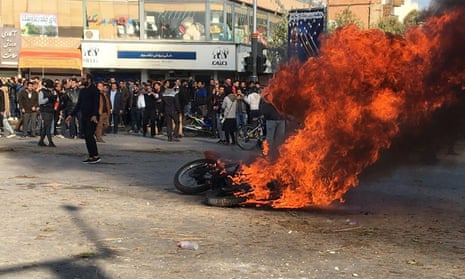Iran’s supreme leader, Ayatollah Ali Khamenei, has backed 50% petrol price increases that have sparked protests across Iran, claiming opponents of the Islamic Republic and foreign enemies were guilty of sabotage.
But there were also moves from Iranian parliamentarians to reverse the rise amid fears the protests could spiral out of control, as they have in Iraq and Lebanon.
Khamenei said on Sunday: “Some people are no doubt worried by this decision ... but sabotage and arson is done by hooligans not our people. The counter-revolution and Iran’s enemies have always supported sabotage and breaches of security and continue to do so.”
He said he did not know about the details behind the price rise, but said it had been sanctioned by Iranian government bodies and experts, and as such should be supported.
The demonstrations took place in more than a dozen cities following the decision of the Iranian president, Hassan Rouhani, at midnight on Friday to cut petrol subsidies to fund support for Iran’s poor. Petrol in the country still remains among the cheapest in the world, with prices jumping to a minimum of 15,000 rials (27p) per litre – 50% up from the day before.
Though largely peaceful, demonstrations turned violent in several instances, with online videos purporting to show police officers firing teargas at protesters and mobs setting fires. While representing a political risk for the president before February’s parliamentary elections, the protests show the widespread anger among Iran’s population of 80 million who have seen their savings evaporate, job scarcity and the collapse of the rial.
Iran is home to the world’s fourth-largest crude oil reserves. While expected for months, the decision to raise petrol prices still caught many by surprise and sparked protests overnight.

Officials said on Saturday that one person had been killed in the south-eastern city of Sirjan. Khamenei said: “Unfortunately some problems were caused, a number of people lost their lives and some centres were destroyed.”
The scale of the protests led the government to block the internet. The internet blockage observatory NetBlocks tweeted late on Saturday: “Iran is now in the midst of a near-total national internet shutdown; realtime network data show connectivity at 7% of ordinary levels after 12 hours of progressive network disconnections as public protests continue.”
A local prosecutor said on Sunday that 40 people had been arrested during protests in the central city of Yazd, most of whom were not local residents, ISNA news agency reported.
Many shops in Tehran’s bazaar closed on Sunday after “disruptions” by people from outside the trading centre, ISNA also reported.
Videos on social media showed riot police firing teargas and using clubs on Saturday to disperse protesters in several cities. A video on Twitter showed protesters torching a bank. Other videos showed a picture of Khamenei being burnt.
The US secretary of state, Mike Pompeo, tweeted his support for the protests, saying “the US is with you”. Washington is likely to see the protests as a vindication of its maximum sanctions policy, which is designed to put such a tight economic squeeze on Tehran that it is forced to renegotiate the 2015 Iran nuclear deal.
But the petrol price increase was not intended primarily as a desperate money-raising measure for the government, but as a calculated means of making the economy more efficient, and switching resources to the poor.
The rise is intended to raise about $2.5bn (£1.9bn) a year for additional subsidies for 18 million families, or about 60 million Iranians on lower incomes, the government said. The proposal had been recommended by the International Monetary Fund as a way of ending inefficient petrol subsidies and rebalancing government spending, Iran has some of the cheapest retail petrol prices in the world partly due to high subsidies. Fuel subsidies cost 1.6% of GDP in 2017-18.
But voters, fed up with corruption, are sceptical that the extra revenue will see its way to society, especially the poor. But Mohammad Bagher Nobakht, the head of Iran’s plan and budget organisation, insisted about 60 million people out of the 82 million population would get an extra monthly bonus to compensate for the rise in petrol prices. He did not provide details but said the first payments would be made within the next week or 10 days.
The interior minister, Abdolreza Rahmani Fazli, told state TV: “Security forces have so far shown restraint and have tolerated the protests. But as the calm and security of people is our priority, they will fulfil their duty to restore calm if attacks on public and individuals’ properties continue.”
Violence broke out on Friday night in Sirjan, a city 800km (500 miles) south-east of Tehran. The state-run IRNA news agency said: “Protesters tried to set fire to the oil depot, but they were stopped by police.” It did not elaborate, but online videos circulating on Iranian social media purported to show a fire at the depot as sirens wailed in the background. Another showed a large crowd shouting: “Rouhani, shame on you. Leave the country alone.”
In Iran’s oil-rich Khuzestan province, online videos purported to show police firing teargas on crowds. There was also gunfire in the province’s city of Khorramshahr, which could be heard in a brief clip played on state television. The region has long been a political tinderbox, with an ethnic Arab population that feels disenfranchised from the country’s Persian-language majority.
